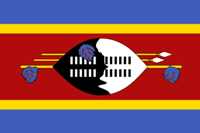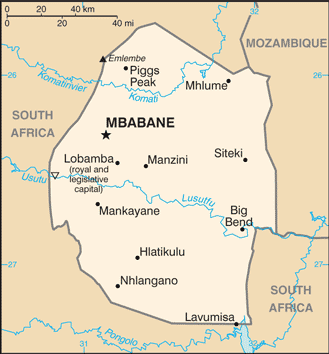Topics Covered
Welcome to Swaziland
Overview of Resources
Industrial Minerals
Metals
Investment
Sources
Welcome to Swaziland
Swaziland, with a total population of 1,386,914 as of July 2012, is located in the southern part of Africa, between Mozambique and South Africa. Swaziland covers a total area of 17,364 km2 and has tropical and temperate climates. The country’s GDP per capita is $5,400 as of 2011.
Swaziland gained its independence in 1968, and is now totally dependent on South Africa for its exports and imports, worker remittances and customs duties from the Southern African Customs Union (SACU).
 |
The national flag of Swaziland.
Image Credit: CIA Factbook |
Swaziland’s natural resources include coal, asbestos, diamond and gold deposits, talc and quarry stones. The country’s mining activities have declined in the recent years, though quarry stone and coal mines remained active. Swaziland is keen on drawing foreign investments and increasing the number of medium and small enterprises.
Overview of Resources
Swaziland’s chief economically beneficial minerals include silica, gold, diamond, kaolin and coal. Tin, copper, arsenic, manganese and nickel are present, but are not often mined as they are regarded as uneconomical due to their low quality or availability in small deposits.
In 2010, Swaziland’s only official mine was the Maloma Mine. Following the decline in the mining sector, the country’s mineral industry also failed to contribute much to Swaziland’s gross domestic product.
Industrial Minerals
The Swaziland Investment Promotions Authority had planned to open a joint venture with the government as part of the talc project. This talc project is located in Forbes Reef, which is suitable for open pit mining. Talc mining in the country attracts foreign investments and provides job opportunities.
Chrysolite fiber asbestos was mined in Bulumbe, one of the largest asbestos mines in the world. This mining operation that generated good revenues ceased due to weak markets, environmental issues and declining reserves.

The map of Swaziland. Image Credit: CIA Factbook
Metals
Iron ore mining in Swaziland is of great significance as it led to the development of the country’s modern industrial phase that included the development of a rail and road infrastructure. This development improved the country’s import and export trade in a cost-effective manner. Nearly 77,500 tons of iron ore from Swaziland was shipped to Japan, the country’s chief ore market. Swaziland’s Ngwenya Mine is known for its iron ore deposits that are globally considered as one of the oldest geological formations. This mine is also the site where the very first mining activity in the world was carried out.
The production of gold in Swaziland was never a continuous activity, but after the Boer war, extraction of gold took place in a small scale and on a regular basis. Of all the gold mines in Swaziland, Forbes Main Reef is the most productive mine in Malolotja and the second most productive mine in Swaziland. In 2001, small scale and illegal gold mining was reported in Swaziland.
Investment
Swaziland’s economy has been declining tremendously in recent times as several mining companies have ceased their operations and a number of coal miners have been complaining about the lack of proper railway lines in the mining regions.
To boost the country’s ailing economy, the government has planned to improve its coal exporting potential. As part of the plan, a new railway line will be constructed in mid-2013. The 146 km long railway line will start from the coal-rich regions of Mpumalanga to Swaziland, and will have the capacity to export an additional 15-million tons a year.
With this new development, Swaziland hopes to improve its revenue through coal exports. However, the future of the country’s mining sector is uncertain and experts feel that it will need to focus a lot more on mineral exploration.
Disclaimer: The Author of this article does not imply any investment recommendation and some content is speculative in nature. The Author is not affiliated in any way with any companies mentioned and all statistical information is publically available.
Sources
Disclaimer: The views expressed here are those of the author expressed in their private capacity and do not necessarily represent the views of AZoM.com Limited T/A AZoNetwork the owner and operator of this website. This disclaimer forms part of the Terms and conditions of use of this website.